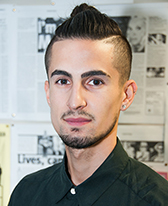They arrive in all sorts of circumstances, some with disembodied limbs and ragged clothes, others with empty eye sockets and loose wigs.
Awaiting assessment, it’s the job of ‘head surgeons’ Anne Weerdenburg and Charles Philipp from the Doll Hospital in Malvern, to rejuvenate and restore them to their original glory.
Established in 1882, Melbourne’s historic Doll Hospital is the oldest of its kind – still working its magic whilst countless others have closed their doors.
“I do know that in the 1900s it was situated in Brunswick and then it moved to the Royal Arcade and it was there for three generations,” says Weerdenburg, who is the co-owner of the business along with her partner Philipp.
Today, Weerdenburg and Philipp repair up to 800 dolls and teddies each year, with demand growing by the day.
“If you bring a doll in, then there’s a hundred before yours,” Weerdenburg says.
The repair procedure for the treasured dolls includes restoring all the broken parts, filling, sanding, painting, restringing and resetting eyes, before it can be passed on for generations to come.
Sometimes the restoration can involve basic work taking no more than a day, whilst other times more complicated repairs can take up to six weeks.

Weerdenburg says their clients get very excited when their special teddies and dolls are mended as they have a sentimental value.
“Some of them burst into tears because they’re so happy. It’s their memories, their childhood and it reminds them of who gave them the doll. That will remind them of their parents, an aunt or an uncle,” she says.
Weerdenburg’s time at the Doll Hospital is equally satisfying and rewarding.
“Preserving the past I guess with the old dolls, and then when I see the doll finished … that gives me a great deal of satisfaction,” she says.
A doll maker of 35 years, Weerdenburg says the history of dolls in Melbourne goes to back to the gold rush era as people bought them to exhibit their wealth.
“In the 1850s we had the gold rush here and Melbourne was a very wealthy city, and the dolls then were made in Germany and France,” she says.
“They were status symbols, so people bought them and sat them in their homes to say that this is what I can afford, and the dolls weren’t played with that much … only played with on a Sunday.”
Known as ‘Marvellous Melbourne’ due to the enormous wealth fuelled from the goldfields, the city became the hotbed of antiques and children’s toys.
“By the 1860s to 1870s there was a need for a doll hospital to restore the antiques,” Weerdenburg says.
“And we’re still restoring those, maybe 30 per cent are the old antique dolls, so they’ve continued through the ages.”
These days, the dolls at the Doll Hospital are in some ways an embodiment of Melbourne’s past.
“The dolls show a social history of what Melbourne was,” Weerdenburg says.
“The wars have an influence as far as materials and products go, so before the war you had a certain type of doll, and after the war they discovered new plastics.”

The vast majority of dolls that arrive in the hospital today are from the 50s and 60s.
Hard-plastic dolls were first introduced in the 1940s, after new plastics were developed during World War II. These dolls were soon overtaken by the more flexible plastics known as ‘vinyl’ in the 1950s.
“So they had hard plastic dolls and now we’ve got vinyl dolls, but it’s a very disposable world,” Weerdenburg says.
Amidst a disposable world where children play with touchscreens more than traditional toys, Weerdenburg believes her business will not fade or die out.
“Children still love their dolls, so there’s a lot of dolls coming and they need clothes, they need shoes and they need fixing. It’s sort of generational … it just keeps going,” she says.
“We’ve been here for a very long time, so hopefully we stay around.”
Deniz Uzgun is a third year Bachelor of Arts student at La Trobe University. Twitter: @uzgundeniz.
is a third year Bachelor of Arts student at La Trobe University. Twitter: @uzgundeniz.







